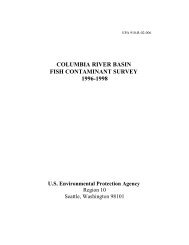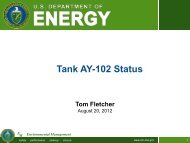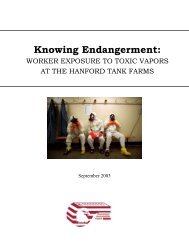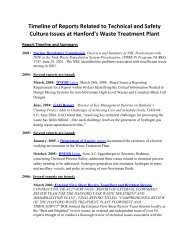Reducing the Risks of High-Level Radioactive Wastes at Hanford
Reducing the Risks of High-Level Radioactive Wastes at Hanford
Reducing the Risks of High-Level Radioactive Wastes at Hanford
Create successful ePaper yourself
Turn your PDF publications into a flip-book with our unique Google optimized e-Paper software.
58 Alvarez<br />
In its June 2001 report <strong>the</strong> NRC identified over two dozen significant safety<br />
issues and over 50 specific topics in <strong>the</strong> current design and approach which<br />
remained to be resolved. 76 “Several scenarios involving large radiochemical<br />
inventories (in tanks), flammable gases, organic ion exchange resin interactions,<br />
glass melters, and cold chemical effects,” according to <strong>the</strong> NRC, “were<br />
found to have potential accident consequences to <strong>the</strong> workers and <strong>the</strong> public <strong>of</strong><br />
significant severity and risk.” 77<br />
The NRC found th<strong>at</strong> plant “has more stored chemical energy for prompt<br />
potential events directly involving <strong>the</strong> radionuclides in <strong>the</strong>ir mobile forms,” 78<br />
and thus, radiological consequences to members <strong>of</strong> <strong>the</strong> public could result in<br />
doses in <strong>the</strong> hundreds or thousands <strong>of</strong> rem.<br />
In arriving <strong>at</strong> this conclusion, <strong>the</strong> NRC was actively involved in <strong>the</strong> development<br />
<strong>of</strong> <strong>the</strong> Documented Safety Analysis (DSA), a required safety document<br />
th<strong>at</strong> extends to <strong>the</strong> design, construction, and oper<strong>at</strong>ion <strong>of</strong> a nuclear facility. 79<br />
The DSA includes a comprehensive hazard analysis associ<strong>at</strong>ed with accident<br />
scenarios th<strong>at</strong> could result in significant consequences to members <strong>of</strong> <strong>the</strong> public<br />
and <strong>the</strong> environment. In turn, <strong>the</strong> hazard analysis is required by regul<strong>at</strong>ion to<br />
include estim<strong>at</strong>es <strong>of</strong> <strong>the</strong> frequency <strong>of</strong> unmitig<strong>at</strong>ed risks, which do not take into<br />
account prevent<strong>at</strong>ive fe<strong>at</strong>ures th<strong>at</strong> would lessen <strong>the</strong> consequences <strong>of</strong> an accident,<br />
“o<strong>the</strong>r than initial conditions and <strong>the</strong> basic physical realities <strong>of</strong> a given<br />
oper<strong>at</strong>ion.” 80 This approach is supposed to envelope uncertainties th<strong>at</strong> provide<br />
adequ<strong>at</strong>e safety margins.<br />
The NRC found th<strong>at</strong> DOE did not “appear to adequ<strong>at</strong>ely address <strong>the</strong> significance<br />
<strong>of</strong> unmitig<strong>at</strong>ed events.” DOE’s “implicit assumptions” would result in<br />
“less severe consequences” and “may result in overlooking and not identifying<br />
safety controls and <strong>the</strong>ir requirements, including reliabilities.” NRC reported<br />
“<strong>the</strong>re still is an apparent bias ... to implicitly r<strong>at</strong>e hazards in a mitig<strong>at</strong>ed<br />
manner ...Thus, it is not clear th<strong>at</strong> safety requirements are being adequ<strong>at</strong>ely<br />
identified and c<strong>at</strong>egorized.” 81<br />
In this context, <strong>the</strong> NRC estim<strong>at</strong>ed <strong>the</strong> total unmitig<strong>at</strong>ed risk <strong>of</strong> major<br />
accidents involving large radi<strong>at</strong>ion releases, such as a melter steam explosion<br />
or a resin fire, <strong>at</strong> <strong>the</strong> <strong>Hanford</strong> vitrific<strong>at</strong>ion plant was 2.4E-2/yr (annual risk <strong>of</strong><br />
2.4 percent). 82 This transl<strong>at</strong>es into a 50–50 chance <strong>of</strong> a major accident over 28<br />
years <strong>of</strong> oper<strong>at</strong>ion. 83 (See Table 2.)<br />
Chemicals also pose significant hazards. Tank failures containing nitric acid<br />
and anhydrous ammonia could cause severe injuries and de<strong>at</strong>h and “render <strong>the</strong><br />
facility uninhabitable” to an area extending beyond a mile. 84<br />
However, NRC found th<strong>at</strong> (with <strong>the</strong> exception <strong>of</strong> <strong>the</strong> glass melters) existing<br />
“mitig<strong>at</strong>ion methods exist th<strong>at</strong> are comp<strong>at</strong>ible with <strong>the</strong> regul<strong>at</strong>ions and <strong>of</strong>fer<br />
<strong>the</strong> potential for reducing process accident risk to more acceptable levels (circa<br />
2E-6/yr).” 85<br />
A melter steam explosion constituted more than 50 percent <strong>of</strong> <strong>the</strong> unmitig<strong>at</strong>ed<br />
risk <strong>of</strong> a c<strong>at</strong>astrophic accident 86 and NRC staff expressed concerns







